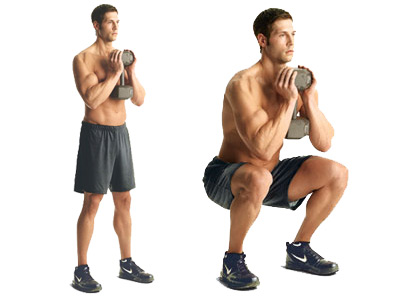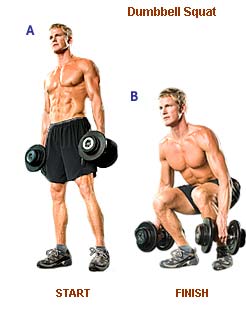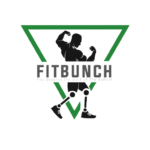What? A fitness professional encouraging you not to squat?!
It may feel counter-intuitive to hear a health/fitness professional discouraging you from doing exercise, but I’ve been seeing a lot of these around social media lately, along with having clients inquiring about them, so I’ve got to step up…
Why it’s a bad idea…
Squat challenges are a recipe for disastrous injury. Challenges similar to the one pictured below, have you start with 50 squats from day one, working your way up to 250 squats in a day over the course of the month, and amounting to around 1,000 squats in the last four days. While you may be under the impression that any exercise is good exercise, and the more the merrier, right? WRONG.

I would venture to say 90%+ of first-time gym-goers fail to assume anything close proper squat form, and even trained individuals have muscular imbalances which can set them up for catastrophic consequences. These imbalances become even more pronounced as repetitions are increased. Tight calves, underdeveloped hamstrings, weak glutes, improper core engagement, and overactive lower backs can all lead to injury, especially as you push north of 50-60 reps.

Squat challenges also neglect any sort of programming (outside of increasing repetitions daily, which is not a good idea) – how are you supposed to divide sets/reps? What about upper body? Is there the 30-Day Push Up/Chin-Up/Overhead Press/Bicep Curl Challenge? What about other exercises for the lower body?
The squat is arguably the “King of all Exercises” – it’s a fundamental human movement pattern, and everybody, regardless of age or ability should seek to incorporate some form of squat into their everyday life – just not at the volume or frequency the “30 Day Squat Challenge”
What to do instead…
Without turning this into an incredibly long article on how to set up a comprehensive exercise program, I’m going to focus here on how to intelligently incorporate a variety of lower-body exercises.
As we just mentioned, the squat is arguably the “King” of exercises – no other movement, weighted or not, incorporates more total muscle or places more stress on the body (this is a good thing!) – However, like anything else in life, too much of a good thing can be bad, and in some cases, can have dire consequences.
First and foremost, your focus needs to be on form! Form over quantity, every single time! If you’re new to this whole fitness thing, let me repeat – FORM IS PARAMOUNT! Now, that being said, there is no “one proper form” for every single individual, so let me give you a brief rundown on some general tips for squatting…

- Feet should be flat, outside of the shoulders
- Toes should be pointed slightly outward
- The movement should initiate at the hips, by pushing them back (“Sit down into a chair”)
- Knees should stay behind the toes, but track in line with the feet
- Natural low back arch
- Arms straight ahead, gaze straight ahead
We aren’t going to spend too much time on body weight squat form, but it is imperative that you know these few things, for they are your starting point. Once the bodyweight squat has been perfected, it’s worth progressing. My typical progression is to the goblet squat, using either a kettlebell (grabbed by the “horns”) or a dumbbell (inverted as shown below). You don’t need your shirt off to perform a proper goblet squat, but you do need to keep all of the same tenets of the bodyweight squat in mind, as well as “bracing” (squeezing your ab muscles – don’t for get to breathe!) and “drawing in” (imagine pulling your belly button in towards your spine) your core. If adequately chosen, the weight is going to draw you forward, and if your core is properly engaged, you’ll be able to resist this!


The goblet squat should be performed as 2-3 sets of 10-15 repetitions at a smooth, even tempo (I usually count 1 second descent, 1 second pause at the bottom, 1 second ascent). I am also an advocate of the dumbbell squat, performed as shown above, or with the dumbbells at the shoulders – as long as there is little to no movement compensation (IE falling forward because the dumbbells are too heavy), go for it!
Beyond the goblet squat, there are innumerable ways to progress the squat. Typically I’ll show barbell back squat, as well as front squat. Past that, we can progress into power movements (jump squat), and more tempo-oriented training. Any one of these is suitable and more effective than performing squats at the higher volumes demanded by the 30 Day Squat Challenge.


Beyond squatting, there are plenty of other lower-body-dominant movements that are of importance, and it’s important to vary what you’re doing from workout to workout. Lunge variations, deadlifts and their variations, as well as single leg movements should all have a place in your workouts.
How many do I do?
Finding adequate sets and repetitions (volume) takes some time, so don’t expect to get it right off the bat. I usually start untrained individuals (read: never before worked out, or haven’t worked out in a considerable time) with 2-3 sets of anywhere between 10-15 body weight squats, but will quickly progress to a weighted variation (usually the Goblet squat) with slightly lower volume (2-3 sets of 8-12).
Adequate volume is also going to vary from person-to-person, so it’s always a good idea to listen to your body and keep a very conscious eye on your form (or have a professional there to do it for you). Pushing through sets and reps just to “feel the burn” doesn’t make your workout more effective, and just because you’re sore the following day doesn’t mean that you’re doing something right. If you’re starting out, expect some soreness, but don’t chase it!
Putting it all together…
While the 30 Day Squat Challenge may seem like a great way to put your best foot forward into fitness, you’re going to be far better off in the long run by intelligently planning workouts and incorporating a wide variety of movements into your program. Instead of focusing on squatting exclusively, spend some time perfecting your form and incorporate other movements into your workouts. A sample beginner level lower-body workout should look something like the following…
- [WARM-UP] Body Weight Squats – 2 sets of 10
- Goblet/Dumbbell Squats – 3 sets of 12
- Lunges – either static (in-place) or walking (new step each time) – 3 sets of 10 per leg
- Romanian Deadlift (either DB/KB) – 2 sets of 10-15
- Single Leg Negative Squat (stand on one leg, slowly lower yourself to a bench) – 2 sets of 10-15/leg
- Lateral Lunge – 2 sets of 10/leg while holding a kettlebell
This is a very basic workout, and by no means all-encompassing, but it’s a starting point for someone who wants to start getting their body into ideal shape! The 30-Day Squat Challenge, while it may seem like an ideal way to keep yourself accountable when first starting a fitness regimen, is less than perfect and fails to take into account the total lower body. Instead, spend your time focusing on a wider variety of movements, keeping your form as perfect as possible, and pushing yourself to get better from workout to workout! This will set you up for more long-term success and also keep you from getting injured.
As always, drop me a line at trevor@fitbunch.net if you need any help or have any questions!
[social_share style=”bar” align=”horizontal” heading_align=”inline” facebook=”1″ twitter=”1″ google_plus=”1″ linkedin=”1″ pinterest=”1″ /]
